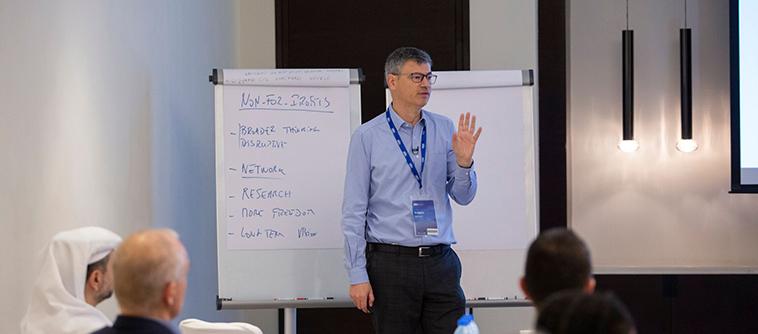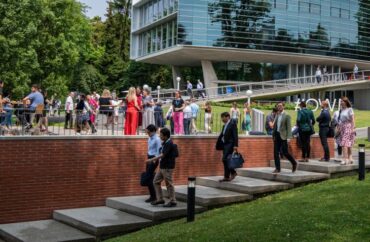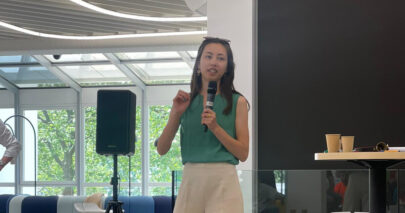What sort of world do you want to leave behind for your children, and your children’s children?
This was the question posed by Frédéric Dalsace, Professor of Marketing and Strategy, at the start of his session at Orchestrating Winning Performance in Dubai.
The world faces a long list of formidable challenges, from climate change and depletion of resources to population growth and growing inequality. “Resources per capita are going down. Some people have lots of resources and some hardly have any, and the gap is getting wider,” said Dalsace.
In 2010, 388 billionaires owned the same amount of wealth as the poorest half of the global population. Today, that figure has narrowed to just 26.
“We have to organize a more efficient and equitable use of our resources – forget everything else. Forget finance, forget negotiations, this is more important,” Dalsace added.
A new type of innovation is needed to tackle these challenges, Dalsace argues. Not disruptive innovation, triadic innovation, frugal innovation, collaborative innovation – or any from the long, long list of innovation types currently familiar to many of us.
Instead, Dalsace is calling for something called ‘Ecosystemic Innovation 2.0’.
What does Ecosystemic Innovation 2.0 look like?
Companies need to start working with new actors, Dalsace says, particularly not-for-profits such as academia, governments, NGOs and charities.
This is merely the continuation of a long-term trend, Dalsace argued. Firms used to be very isolated and operated within their own internal – albeit extended – ecosystem, doing their own innovating and handling their own supply chains, for example.
“It’s good to have an ecosystem, but it needs to become more open,” he said.
What do non-profits bring to the table?
Legitimacy, says Dalsace. Reputation, a license to operate, the ability to attract and retain employees as well as expertise and a long-term mindset that isn’t just focused on quarterly results.
They also offer resources, he adds, in terms of a huge network of volunteers, communities and other people who can help firms to get things done.
Who is doing it?
Sharing real world examples of ecosystemic innovation in action, Dalsace spoke about the Toilet Board Coalition (TBC), which is aiming to address the global sanitation crisis by accelerating what it calls the “sanitation economy” – making money out of human waste.
In its own words, the TBC is “connecting large and small companies and ensuring close collaboration between private, public and non-profit sectors with the common goal to achieve Sustainable Development Goal 6 (SDG6), universal access to sanitation.”
The list of partners is notable not just for number and size of the companies involved – Uniliver, Kimberley Clark, Tata, to name just a few – but also the involvement of the likes of the London School of Hygiene and Tropical Medicine, WaterAid, Water.org, the World Bank and Unicef
All of these partners share one goal – they believe that they can deliver significant impact to both business and society.
Livelihoods, meanwhile, “funds and promotes farming practices that can increase food production while preserving our natural resources.” It’s made up of a long list of private and public organizations, NGOs and social enterprises that has, among other things, invested in family farmers to improve supply chains – which has obvious benefits for all parties.
The fund has also spent 40 million euros planting 130 million trees and equipping houses with better stoves. In return for, restoring ecosystems and investing in rural energy projects. In return for restoring natural ecosystems and reducing pollution, investors receive carbon credits.
Meanwhile, Optique Solidaire wants to give poor people living in France access to quality eyewear. They have partnered with organizations along the entire ecosystem: insurance companies, frame makers, and companies making the vouchers for people who will benefit from the cheaper glasses, which are now available in more than 500 opticians in France for a fraction of their normal cost.
These types of mutually beneficial relationships are very hard for companies to do on their own, Dalsace says.
Principles of Ecosystemic Innovation 2.0
It is possible to do well by doing good, Dalsace stressed. But for Ecosystemic Innovation 2.0 to be successfully deployed, firms need to remember that it is “not your traditional corporate responsibility. You need to reorient. These are business ventures, not a CSR initiative.”
The process also requires a clear captain, Dalsace said, and you must develop a program of experimentations, “because you will fail first time.”
Dalsace also spoke about the need to develop an unusually high level of transparency, and for members of both the traditional and non-traditional businesses talk to each other, as this is where the innovation will occur.
Ecosystemic Innovation may not drive profits in the way a traditional business does, Dalsace added, but you will motivate people, gain a license to operate and gain social capital. These three together will have an impact on your top and bottom line, he said.
“The ‘doing well by doing good’ model is pretty well established,” Dalsace wrapped up the session by saying. “You might not make as much money, but you can do well. If you do it properly.”




